2022 HYUNDAI SANTA CRUZ climate control
[x] Cancel search: climate controlPage 303 of 598
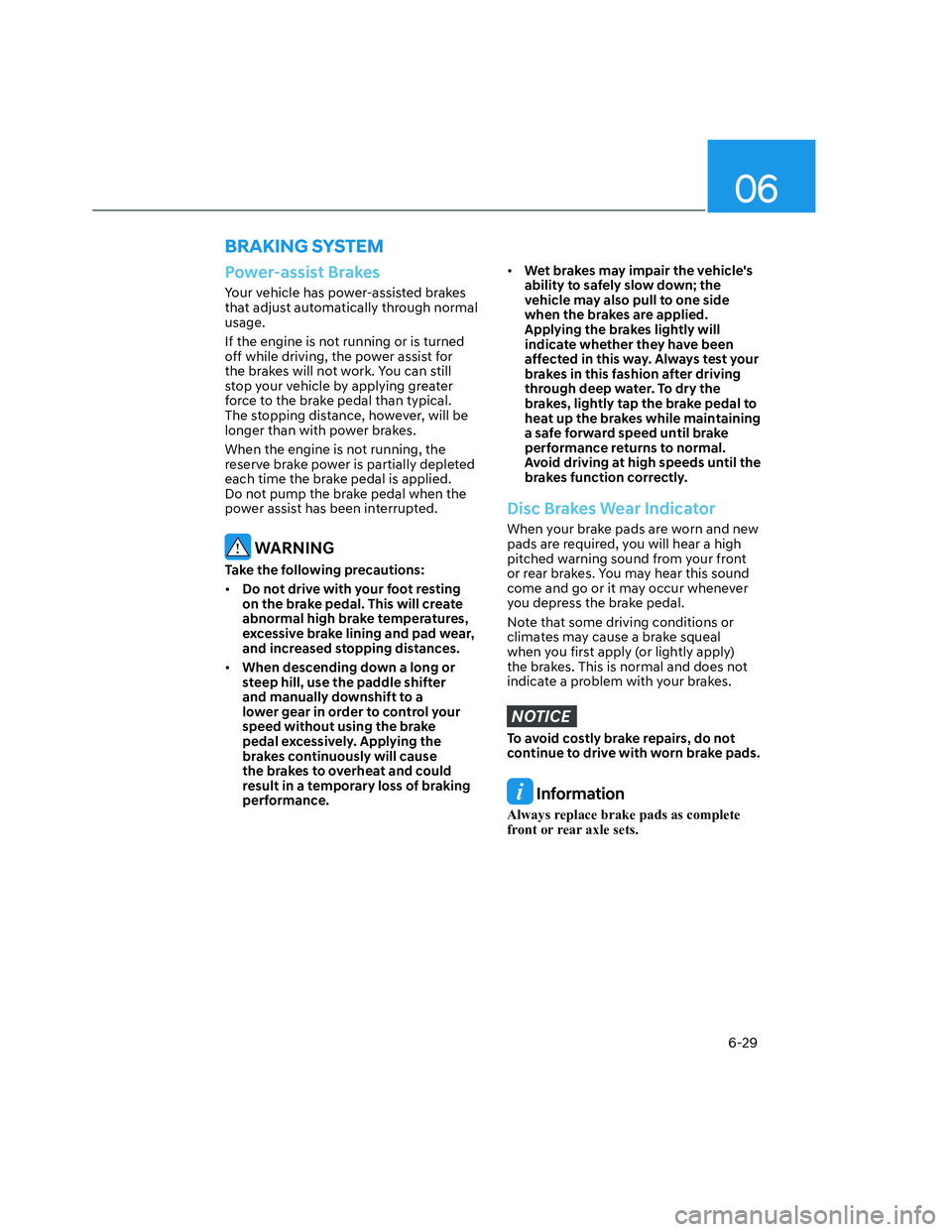
06
6-29
BRAKING SYSTEM
Power-assist Brakes
Your vehicle has power-assisted brakes
that adjust automatically through normal
usage.
If the engine is not running or is turned
off while driving, the power assist for
the brakes will not work. You can still
stop your vehicle by applying greater
force to the brake pedal than typical.
The stopping distance, however, will be
longer than with power brakes.
When the engine is not running, the
reserve brake power is partially depleted
each time the brake pedal is applied.
Do not pump the brake pedal when the
power assist has been interrupted.
WARNING
Take the following precautions:
• Do not drive with your foot resting
on the brake pedal. This will create
abnormal high brake temperatures,
excessive brake lining and pad wear,
and increased stopping distances.
• When descending down a long or
steep hill, use the paddle shifter
and manually downshift to a
lower gear in order to control your
speed without using the brake
pedal excessively. Applying the
brakes continuously will cause
the brakes to overheat and could
result in a temporary loss of braking
performance.
• Wet brakes may impair the vehicle's
ability to safely slow down; the
vehicle may also pull to one side
when the brakes are applied.
Applying the brakes lightly will
indicate whether they have been
affected in this way. Always test your
brakes in this fashion after driving
through deep water. To dry the
brakes, lightly tap the brake pedal to
heat up the brakes while maintaining
a safe forward speed until brake
performance returns to normal.
Avoid driving at high speeds until the
brakes function correctly.
Disc Brakes Wear Indicator
When your brake pads are worn and new
pads are required, you will hear a high
pitched warning sound from your front
or rear brakes. You may hear this sound
come and go or it may occur whenever
you depress the brake pedal.
Note that some driving conditions or
climates may cause a brake squeal
when you first apply (or lightly apply)
the brakes. This is normal and does not
indicate a problem with your brakes.
NOTICE
To avoid costly brake repairs, do not
continue to drive with worn brake pads.
Information
Always replace brake pads as complete
front or rear axle sets.
Page 521 of 598
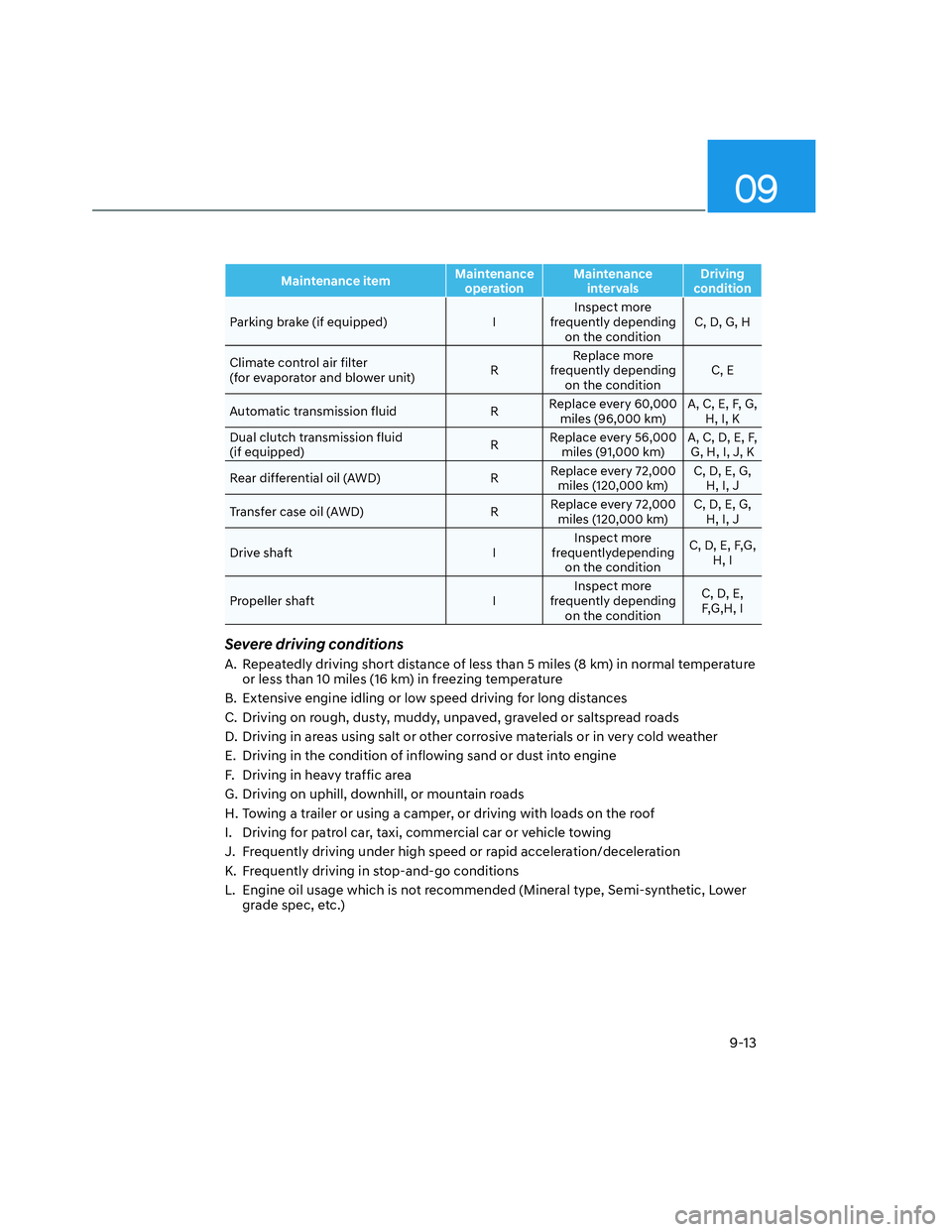
09
9-13
Maintenance itemMaintenance
operationMaintenance
intervalsDriving
condition
Parking brake (if equipped) IInspect more
frequently depending
on the conditionC, D, G, H
Climate control air filter
(for evaporator and blower unit)RReplace more
frequently depending
on the conditionC, E
Automatic transmission fluid RReplace every 60,000
miles (96,000 km)A, C, E, F, G,
H, I, K
Dual clutch transmission fluid
(if equipped)RReplace every 56,000
miles (91,000 km)A, C, D, E, F,
G, H, I, J, K
Rear differential oil (AWD) RReplace every 72,000
miles (120,000 km)C, D, E, G,
H, I, J
Transfer case oil (AWD) RReplace every 72,000
miles (120,000 km)C, D, E, G,
H, I, J
Drive shaft IInspect more
frequentlydepending
on the conditionC, D, E, F,G,
H, I
Propeller shaft IInspect more
frequently depending
on the conditionC, D, E,
F,G,H, I
Severe driving conditions
A. Repeatedly driving short distance of less than 5 miles (8 km) in normal temperature
or less than 10 miles (16 km) in freezing temperature
B. Extensive engine idling or low speed driving for long distances
C. Driving on rough, dusty, muddy, unpaved, graveled or saltspread roads
D. Driving in areas using salt or other corrosive materials or in very cold weather
E. Driving in the condition of inflowing sand or dust into engine
F. Driving in heavy traffic area
G. Driving on uphill, downhill, or mountain roads
H. Towing a trailer or using a camper, or driving with loads on the roof
I. Driving for patrol car, taxi, commercial car or vehicle towing
J. Frequently driving under high speed or rapid acceleration/deceleration
K. Frequently driving in stop-and-go conditions
L. Engine oil usage which is not recommended (Mineral type, Semi-synthetic, Lower
grade spec, etc.)
Page 532 of 598
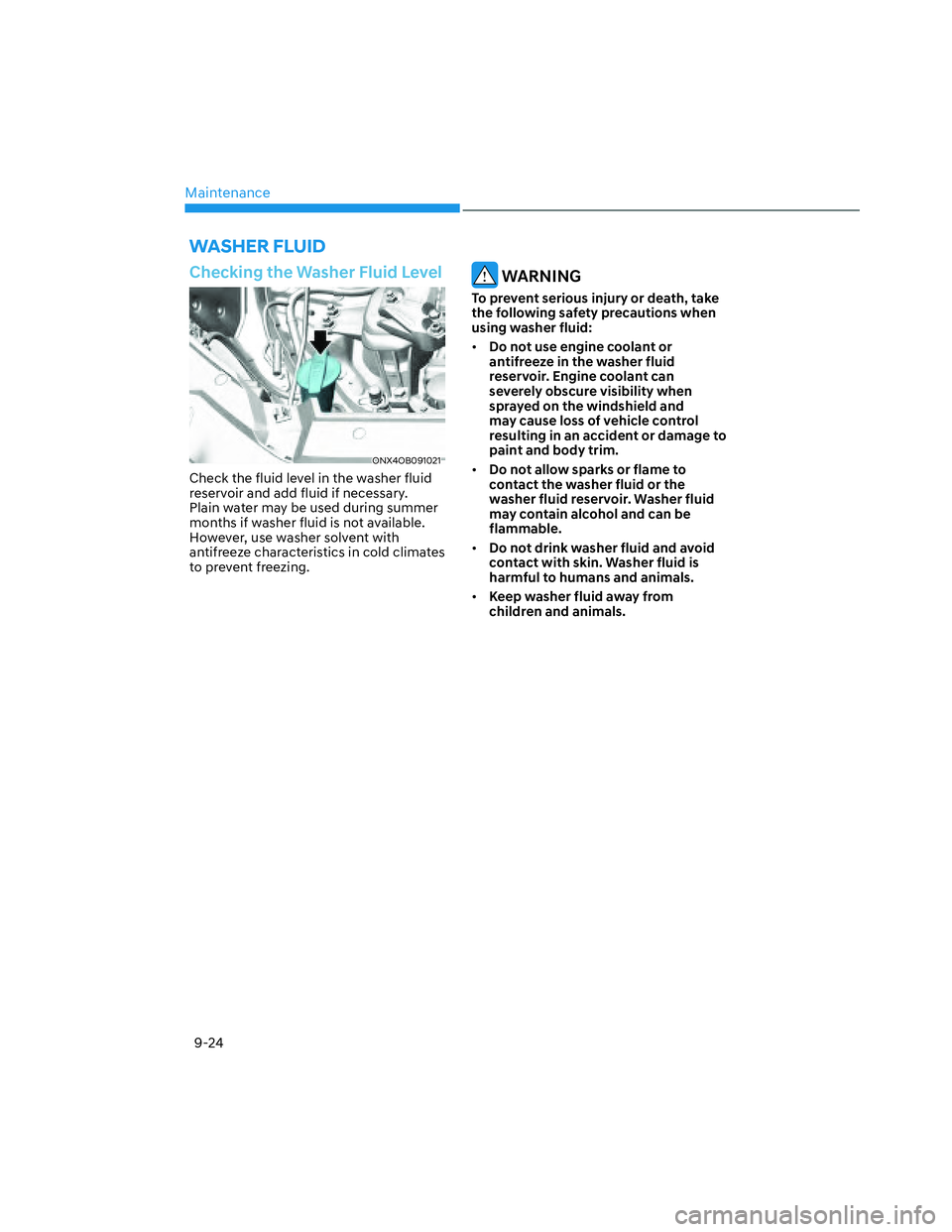
Maintenance
9-24
WASHER FLUID
Checking the Washer Fluid Level
ONX4OB091021ONX4OB091021
Check the fluid level in the washer fluid
reservoir and add fluid if necessary.
Plain water may be used during summer
months if washer fluid is not available.
However, use washer solvent with
antifreeze characteristics in cold climates
to prevent freezing.
WARNING
To prevent serious injury or death, take
the following safety precautions when
using washer fluid:
• Do not use engine coolant or
antifreeze in the washer fluid
reservoir. Engine coolant can
severely obscure visibility when
sprayed on the windshield and
may cause loss of vehicle control
resulting in an accident or damage to
paint and body trim.
• Do not allow sparks or flame to
contact the washer fluid or the
washer fluid reservoir. Washer fluid
may contain alcohol and can be
flammable.
• Do not drink washer fluid and avoid
contact with skin. Washer fluid is
harmful to humans and animals.
• Keep washer fluid away from
children and animals.
Page 542 of 598
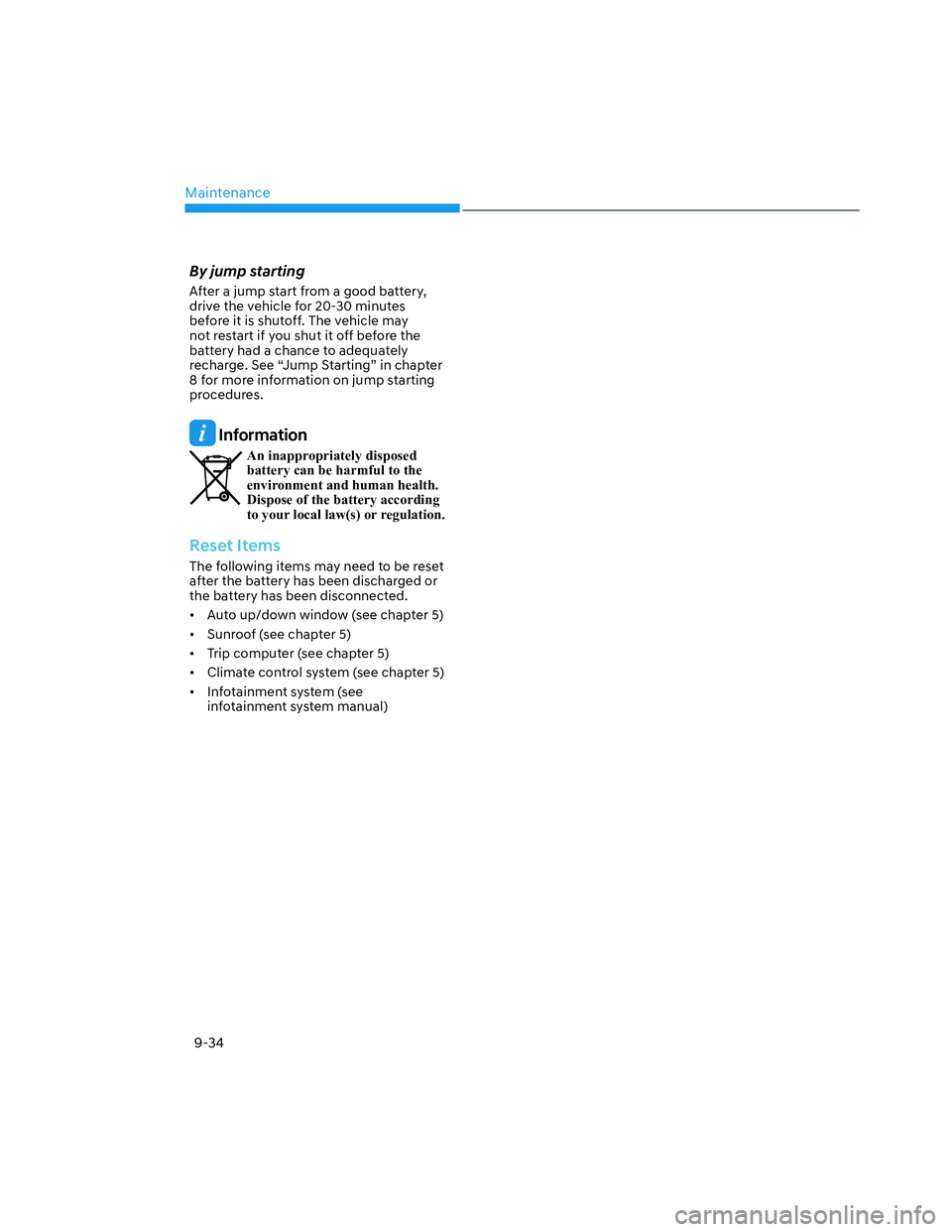
Maintenance
9-34
By jump starting
After a jump start from a good battery,
drive the vehicle for 20-30 minutes
before it is shutoff. The vehicle may
not restart if you shut it off before the
battery had a chance to adequately
recharge. See “Jump Starting” in chapter
8 for more information on jump starting
procedures.
Information
An inappropriately disposed
battery can be harmful to the
environment and human health.
Dispose of the battery according
to your local law(s) or regulation.
Reset Items
The following items may need to be reset
after the battery has been discharged or
the battery has been disconnected.
• Auto up/down window (see chapter 5)
• Sunroof (see chapter 5)
• Trip computer (see chapter 5)
• Climate control system (see chapter 5)
• Infotainment system (see
infotainment system manual)
Page 546 of 598
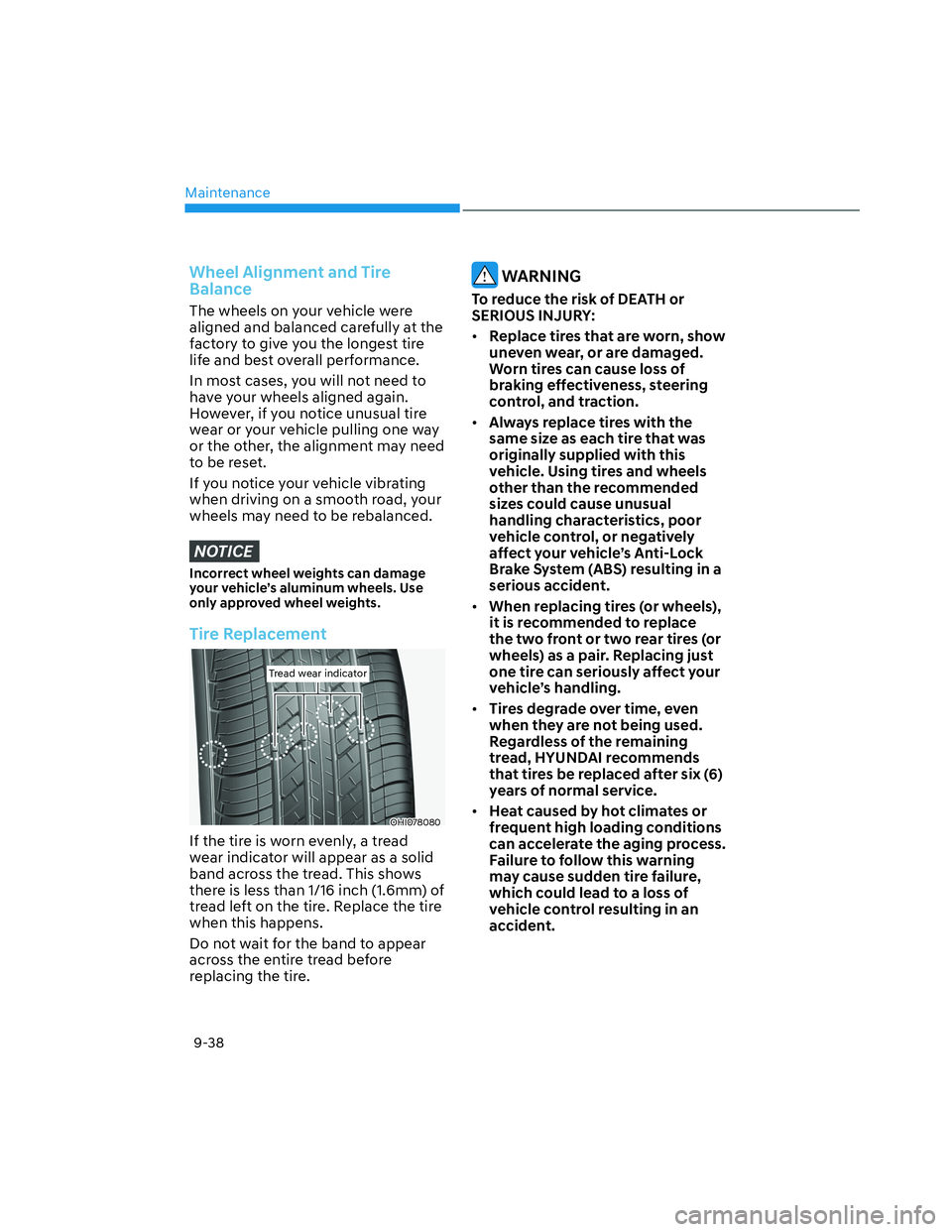
Maintenance
9-38
Wheel Alignment and Tire
Balance
The wheels on your vehicle were
aligned and balanced carefully at the
factory to give you the longest tire
life and best overall performance.
In most cases, you will not need to
have your wheels aligned again.
However, if you notice unusual tire
wear or your vehicle pulling one way
or the other, the alignment may need
to be reset.
If you notice your vehicle vibrating
when driving on a smooth road, your
wheels may need to be rebalanced.
NOTICE
Incorrect wheel weights can damage
your vehicle’s aluminum wheels. Use
only approved wheel weights.
Tire Replacement
Tread wear indicatorTread wear indicator
OHI078080OHI078080
If the tire is worn evenly, a tread
wear indicator will appear as a solid
band across the tread. This shows
there is less than 1/16 inch (1.6mm) of
tread left on the tire. Replace the tire
when this happens.
Do not wait for the band to appear
across the entire tread before
replacing the tire.
WARNING
To reduce the risk of DEATH or
SERIOUS INJURY:
• Replace tires that are worn, show
uneven wear, or are damaged.
Worn tires can cause loss of
braking effectiveness, steering
control, and traction.
• Always replace tires with the
same size as each tire that was
originally supplied with this
vehicle. Using tires and wheels
other than the recommended
sizes could cause unusual
handling characteristics, poor
vehicle control, or negatively
affect your vehicle’s Anti-Lock
Brake System (ABS) resulting in a
serious accident.
• When replacing tires (or wheels),
it is recommended to replace
the two front or two rear tires (or
wheels) as a pair. Replacing just
one tire can seriously affect your
vehicle’s handling.
• Tires degrade over time, even
when they are not being used.
Regardless of the remaining
tread, HYUNDAI recommends
that tires be replaced after six (6)
years of normal service.
• Heat caused by hot climates or
frequent high loading conditions
can accelerate the aging process.
Failure to follow this warning
may cause sudden tire failure,
which could lead to a loss of
vehicle control resulting in an
accident.
Page 550 of 598

Maintenance
9-42
7. Uniform tire quality grading
Quality grades can be found where
applicable on the tire sidewall
between tread shoulder and
maximum section width.
For example:
TREADWEAR 200
TRACTION AA
TEMPERATURE A
Tread wear
The tread wear grade is a
comparative rating based on the
wear rate of the tire when tested
under controlled conditions on a
specified government test course.
For example, a tire graded 150 would
wear one-and-a-half times (1½) as
well on the government course as a
tire graded 100.
The relative performance of tires
depends upon the actual conditions
of their use, however, and may
depart significantly from the norm
due to variations in driving habits,
service practices and differences in
road characteristics and climate.
These grades are molded on the
sidewalls of passenger vehicle tires.
The tires available as standard or
optional equipment on your vehicle
may vary with respect to grade.
Traction - AA, A, B & C
The traction grades, from highest
to lowest, are AA, A, B and C. Those
grades represent the tire’s ability to
stop on wet pavement as measured
under controlled conditions on
specified government test surfaces
of asphalt and concrete. A tire
marked C may have poor traction
performance.
WARNING
The traction grade assigned to
this tire is based on straight ahead
braking traction tests, and does not
include acceleration, cornering,
hydroplaning, or peak traction
characteristics.
Page 586 of 598
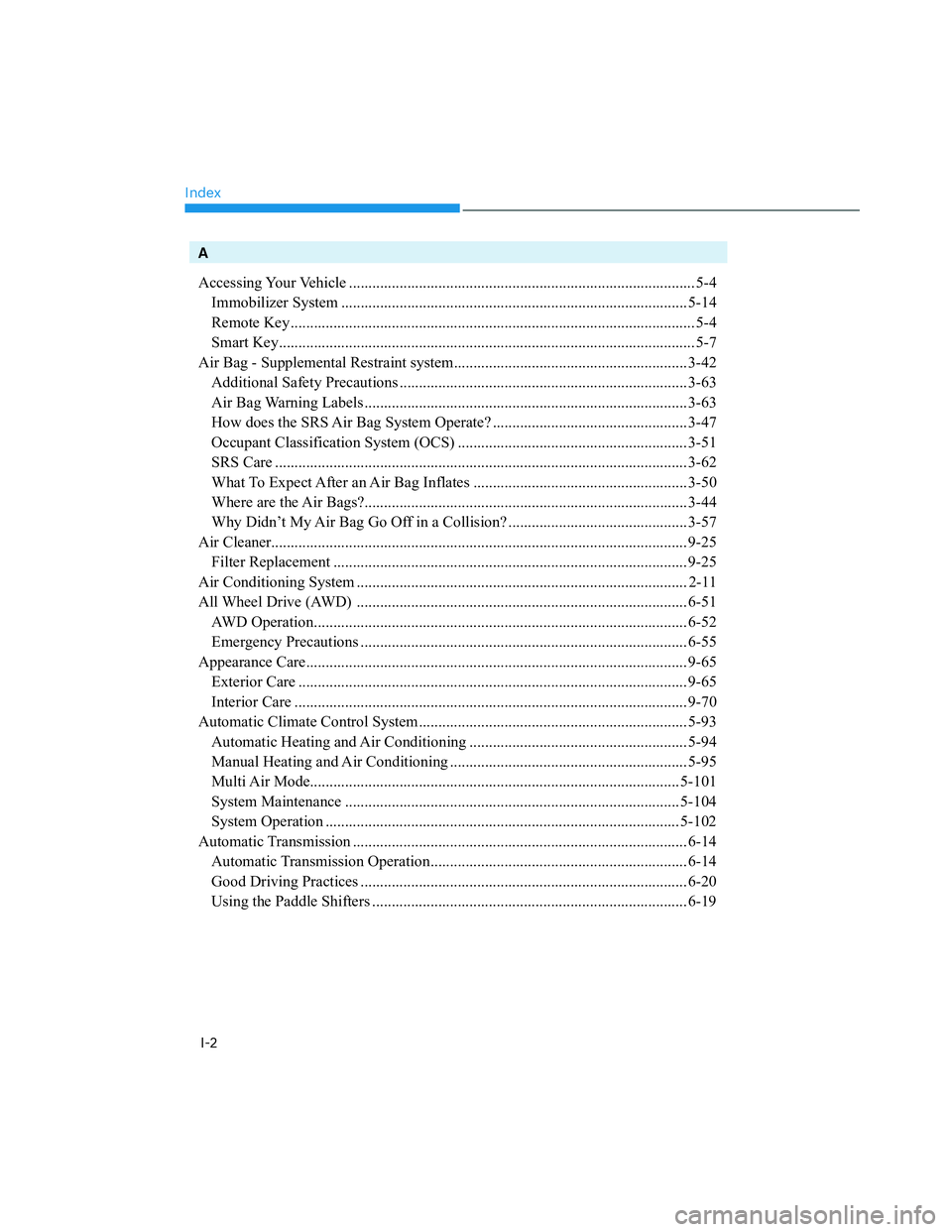
Index
I-2
A
Accessing Your Vehicle ......................................................................................... 5-4
Immobilizer System ......................................................................................... 5-14
Remote Key ........................................................................................................ 5-4
Smart Key........................................................................................................... 5-7
Air Bag - Supplemental Restraint system............................................................ 3-42
Additional Safety Precautions .......................................................................... 3-63
Air Bag Warning Labels ................................................................................... 3-63
How does the SRS Air Bag System Operate? .................................................. 3-47
Occupant Classification System (OCS) ........................................................... 3-51
SRS Care .......................................................................................................... 3-62
What To Expect After an Air Bag Inflates ....................................................... 3-50
Where are the Air Bags?................................................................................... 3-44
Why Didn’t My Air Bag Go Off in a Collision? .............................................. 3-57
Air Cleaner........................................................................................................... 9-25
Filter Replacement ........................................................................................... 9-25
Air Conditioning System ..................................................................................... 2-11
All Wheel Drive (AWD) ..................................................................................... 6-51
AWD Operation................................................................................................ 6-52
Emergency Precautions .................................................................................... 6-55
Appearance Care.................................................................................................. 9-65
Exterior Care .................................................................................................... 9-65
Interior Care ..................................................................................................... 9-70
Automatic Climate Control System..................................................................... 5-93
Automatic Heating and Air Conditioning ........................................................ 5-94
Manual Heating and Air Conditioning ............................................................. 5-95
Multi Air Mode............................................................................................... 5-101
System Maintenance ...................................................................................... 5-104
System Operation ........................................................................................... 5-102
Automatic Transmission ...................................................................................... 6-14
Automatic Transmission Operation.................................................................. 6-14
Good Driving Practices .................................................................................... 6-20
Using the Paddle Shifters ................................................................................. 6-19
Page 588 of 598

Index
I-4
C
Cabin Air Filter .................................................................................................... 9-27
Filter Inspection................................................................................................ 9-27
Filter Replacement ........................................................................................... 9-27
California Perchlorate Notice .............................................................................. 9-76
Child Restraint System (CRS) ............................................................................. 3-31
Children Always in the Rear ............................................................................ 3-31
Installing a Child Restraint System (CRS)....................................................... 3-34
Selecting a Child Restraint System (CRS) ....................................................... 3-32
Climate Control Additional Features ................................................................. 5-109
Auto Defogging System on Models with Automatic Temperature Control ... 5-109
Auto Dehumidify............................................................................................ 5-110
Automatic Controls for the Driver Based on Climate Control System
Settings ......................................................................................................... 5-111
Recirculating Air when washer fluid is used.................................................. 5-111
Sunroof Inside Air Recirculation.................................................................... 5-111
Consumer Information......................................................................................... 2-16
Cruise Control (CC) ............................................................................................ 7-72
Cruise Control Operation ................................................................................ 7-72
D
Declaration of conformity ................................................................................. 7-131
Front Radar..................................................................................................... 7-131
Rear Corner Radar ......................................................................................... 7-131
Dimensions ............................................................................................................ 2-8
Door Locks .......................................................................................................... 5-32
Auto Door Lock/Unlock Features .................................................................... 5-36
Child-protector Rear Door Locks..................................................................... 5-36
Operating Door Locks From Outside the Vehicle ............................................ 5-32
Operating Door Unlocks from Inside the Vehicle ............................................ 5-34
Drive Mode Integrated Control System .............................................................. 6-48
Driver Attention Warning (DAW) ...................................................................... 7-64
Driver Attention Warning Malfunction and Limitations .................................. 7-67
Driver Attention Warning Operation ................................................................ 7-65
Driver Attention Warning Settings .................................................................. 7-64
Dual Clutch Transmission ................................................................................... 6-21
Dual Clutch Transmission Operation ............................................................... 6-21
Good Driving Practices ................................................................................... 6-28
Parking ............................................................................................................. 6-27